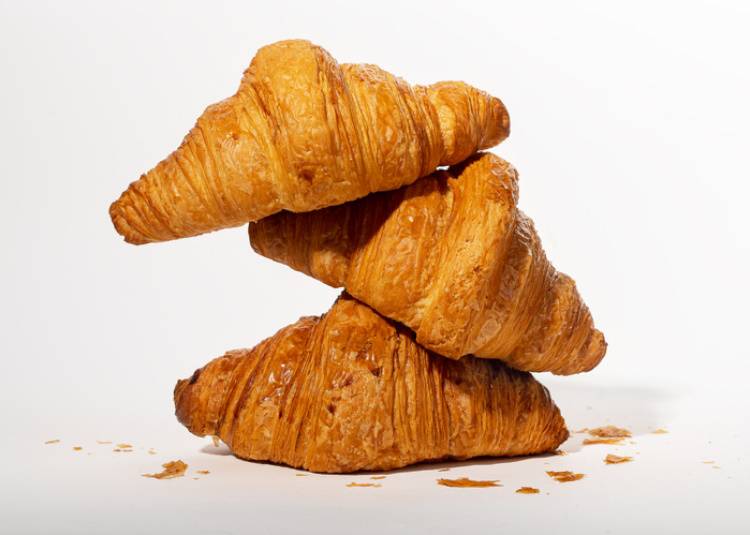The Scottish producer of premium, cultured butters has issued a call out for bakers to put their skills to the test to compete for the title of Scotland’s Best Croissant.
The competition is open to all – from home-based microbakers to professional pâtissiers – who plough their trade in Scotland, but especially those who take bakery to the next level. From the classic butter croissant to the pan au chocolate or even pushing the boundaries of flavor, form and presentation, croissants offers a beautiful canvas for bakers to reinvent the classic pastry.
Infusing the dough with matcha, yuzu, miso or spices like cardamom, za’atar or garam masala; while natural colorants like beetroot powder, activated charcoal or turmeric to ramp up the visual appeal. Creative toppings – think nuts, granola or cocoa nibs – add texture and a rosewater or orange blossom glaze will add another nuance of taste. Think size: mini croissants offer a bite-sized snack while giant croissants can be a showstopping centerpiece. How about a tower of mini croissants, similar to a croquembouche?
The possibilities are endless and The Edinburgh Butter Company is urging bakers to pull out all the stops.
The secret ingredient behind Scotland’s finest viennoiserie
The sole requirement is that their croissants must be crafted using the company’s sheet butter, which has been specially formulated for pastry lamination. This technique is used to make croissants, puff pastry and other laminated doughs as it ensures consistent layers and an exceptional end product. Pastry butter is also known as dry butter has a higher fat and lower water content than normal butter. The drier texture of the butter means it retains its form yet is malleable when being folded for viennoiserie.
Each entrant will receive 2x1kg of Edinburgh Butter Company unsalted butter sheets in early October to make their creations.
“We feel our cultured butter has long been the secret ingredient behind Scotland’s finest viennoiserie,” said Chloe Black, director of The Edinburgh Butter Company.
“After hearing from our talented network of bakers, we realized there was a strong desire for a competition that truly celebrates the craftsmanship of croissant-making.
“We saw an opportunity to create an event that focuses on the quality of individual creations, ensuring that every bakery in Scotland has a fair chance to shine. This competition is our way of honoring their passion and dedication.”
Are you ready to be judged?
Judging will take place at The Balmoral Hotel in Edinburgh on October 28. Entrants will be required to present six croissants to the panel of judges, which comprises some of the UK’s leading pastry chefs, including Ross Sneddon, executive pastry chef at The Balmoral Hotel.
Other judges include Darcie Maher, owner of Lannan Bakery; Kayleigh Turner, head pastry chef at the two Michelin-starred The Glenturret Lalique Restaurant in Perthshire; John Whaite, winner of The Great British Bake Off and owner of Ruff Puff; and food and travel writer and blogger Milly Kenny-Ryder (thoroughlymodernmilly.com) who has been named in the Top 10 Food & Travel influencers by The Evening Standard. Chloe Black rounds off the jury.
Judging criteria will focus on appearance (uniformity, color and shape), pastry development and lamination skills, texture and taste.
Sponsored by The Balmoral Hotel, Rackmaster Limited, Baking & Catering Equipment, Mark Murphy and Tipo Restaurant, the winner will receive a trophy and a meal for two at Tipo, which is fast gaining a reputation as a standard spot in Edinburg’s dining scene. Then there’s the praise, acclaim and recognition that comes with winning: from making the news to social media highlights and even driving footfall into your bakery.
Second Prize is a £150 voucher for Rackmaster bakery equipment, while the third placed will receive an Edinburgh Butter Company goodie bag.
Judging will take place between 10:30am and 12 noon on Monday, October 28, followed by a prizegiving ceremony, refreshments and networking opportunities.
Contestants must register on Scotland’sBestCroissant by Friday, October 4 to secure their spot.
The Edinburgh Butter Company was founded in 2018 by the Black family to produce cultured butter using traditional methods and locally-sourced ingredients. British cream is cultured into a thick, silky crème fraîche and then slow-churned in small batches to create butters with rich flavor and a smooth texture. The family’s goal was to create a product that would stand out for its exceptional taste and craftsmanship, appealing to both professional chefs and home bakers alike.



